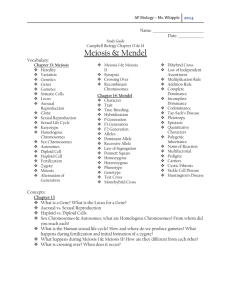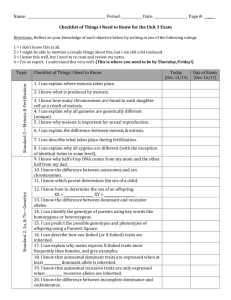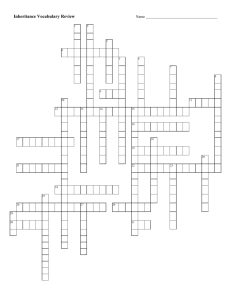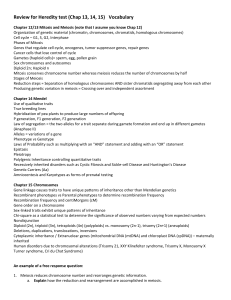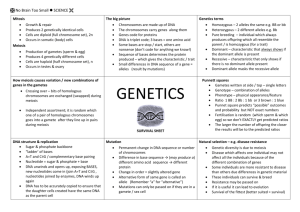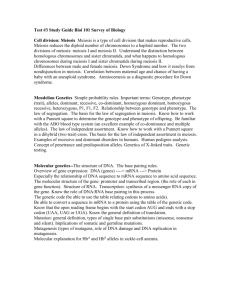TOPIC: Genteics, Mitosis, Meiosis
advertisement
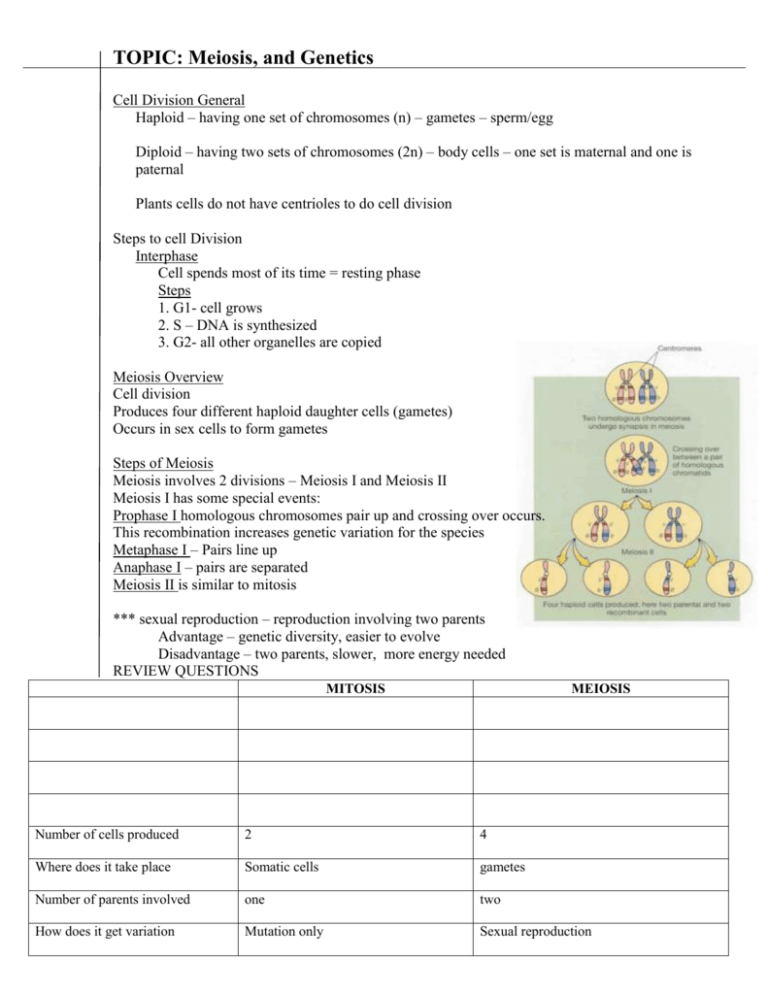
TOPIC: Meiosis, and Genetics Cell Division General Haploid – having one set of chromosomes (n) – gametes – sperm/egg Diploid – having two sets of chromosomes (2n) – body cells – one set is maternal and one is paternal Plants cells do not have centrioles to do cell division Steps to cell Division Interphase Cell spends most of its time = resting phase Steps 1. G1- cell grows 2. S – DNA is synthesized 3. G2- all other organelles are copied Meiosis Overview Cell division Produces four different haploid daughter cells (gametes) Occurs in sex cells to form gametes Steps of Meiosis Meiosis involves 2 divisions – Meiosis I and Meiosis II Meiosis I has some special events: Prophase I homologous chromosomes pair up and crossing over occurs. This recombination increases genetic variation for the species Metaphase I – Pairs line up Anaphase I – pairs are separated Meiosis II is similar to mitosis *** sexual reproduction – reproduction involving two parents Advantage – genetic diversity, easier to evolve Disadvantage – two parents, slower, more energy needed REVIEW QUESTIONS MITOSIS MEIOSIS Number of cells produced 2 4 Where does it take place Somatic cells gametes Number of parents involved one two How does it get variation Mutation only Sexual reproduction TOPIC: Genetics Inheritance • Traits are specific characteristics inherited from parents • Genes are the factors that determine traits • The different forms of a gene are called alleles • We have two genes for each trait – this is our GENOTYPE • One gene came from mom, one from dad • Introduction of a new member to a population increases genetic Variation All organisms share the same genetic code. Order of nitrogenous bases determines phenotype Genotype actual alleles an individual has for a trait (letters) Homozygous • Both alleles are the same Ex. BB or bb Heterozygous • Both alleles are different Ex. Bb Dominate or Recessive • Dominant alleles are expressed, if present, and recessive are hidden Phenotype The actual characteristic displayed by the individual (ex. brown eyes, Hemophiliac) REVIEW QUESTIONS 8. In the Punnett square to the left, T = tall and t=short. Give the parents genotypes.Heterozygous 9. Give the phenotype for the parents. Tall 10. What are the genotypes and phenotypes of the offspring? Genotype : 25%TT, 50%Tt, 25tt Phenotype: 75% tall, 25% short 11. What is the genotypic ratio of the offspring? 12. What is the phenotypic ratio of the offspring? Codominance • Heterozygote expresses BOTH dominant and recessive traits • Ex. Roan animals, blood type AB, spotted chickens Incomplete Dominance • Heterozygote shows a blending of the dominant and recessive phenotypes Polygenic traits • Traits are influenced by more than one gene • Ex. skin color, height, hair color 1:2:1 Multiple Alleles • More than two alleles for a trait (an individual still only inherits two) • Ex. Blood Type (IA,IB, i) type A = IAIA or IAi type O = ii type B = IBIB or IBi type AB= IAI REVIEW QUESTIONS 13. Some genes produce intermediate phenotypes. Cross a pure breeding red flower (RR) with a pure breeding white flower (WW). Give the genotypes and phenotypes of the offspring. WR = PINK 14. What type of inheritance is this? ___incomplete dominance 15. If a woman with type A blood has a child with a man with type B blood and their first child has type O blood, give the genotypes of the woman and the man and do the cross. (Alleles are IA, IB, and i) Iai, Ibi 16. What are the odds that they will have a child with type O blood again? ______25%______ 17. What are the odds that they will have a child with homozygous type A blood? ___0%__________ 18. What are the odds that they will have a child with type AB blood? ______25%________________ 19. A blood test is done to see if one of three men is the father of a child. The child has type O blood, the mother has type A blood. Man #1 has type AB blood, Man #2 has type A blood, Man #3 has type O blood. Are there any men that can be ruled out as the father? Explain .Man #1 he has no gene for type O blood 20. Using 3 genes (A,a and B,b and C,c) explain hair color in terms of these genes. How many phenotypes are possible? 27 Sex-linked Traits • Sex Chromosomes – Female = XX – Male = XY • Sex linked traits are carried on the X chromosome • Ex. Hemophilia, red-green colorblindness • For a female to inherit the trait the father must have it and the mother must at least be a carrier Test Cross • used to determine the phenotype of an unknown dominant individual • uses a homozygous recessive individual as the “test” REVIEW QUESTIONS 21. What are the sex chromosomes in males? ____XY_________ In Females? _____XX_________ 22. Colorblindness & hemophilia are sex-linked traits. What chromosome location (#) are these genes found? X 23. Cross a female who is a carrier for hemophilia with a normal male. ___XBXb______ x ___XbY_______ 24. What are the odds that they will have a child with hemophilia? ______25%________ 25. What are the odds that they will have a daughter with hemophilia? 0% 26. What are the odds that they will have a daughter who is a carrier for hemophilia? __0%____ 27. Why are males more likely to show this type of disorder? (Who (mother/father) is likely to give them the bad gene?) 28. Double check your learning, solve the following genetics problem: A brown mink crossed with a silverblue mink produced all brown offspring. When these F1 mink were crossed among themselves they produced 47 brown animals and 15 silverblue animals (F2 generation). Determine all the genotypes and phenotypes, and their relative ratios, in the F1 and F2 generations. F1 100% Bb, 100% brown F2 25% BB, 50% Bb and 25%bb Pedigree • similar to a family tree • Shows pattern of inheritance of a specific trait through a family REVIEW QUESTIONS 29. Using A,a, what is the genotype of person II4? aa 30. What is the genotype of person I3? Aa Karyotype A chart showing arrangement of chromosomes • In humans, 22 pair of autosomes • 1 pair of sex chromosomes • XX = female • XY = male • Extra chromosomes a result of nondisjunction • Chromosome pairs fail to separate in meiosis during prophase I • One example is DOWN SYNDROME (extra 21) • Another example is KLINEFELTERS (XXY) REVIEW QUESTIONS 31. What is the gender of the person whose karyotype is shown to the left? ____frmale______ 32. What is the disorder that this person has? Trisomy 21 (Down Syndrome) 33. What is your evidence? Two x chromosomes and 3 #21 chromosomes Human Genome Project • Sequencing of human DNA • Being used to develop gene therapies Clone • An organism made from one cell of another organism • A genetically identical copy Gel Electrophoresis • Technique used to separate molecules (DNA or proteins) based on their size • Sometimes called a DNA fingerprint • Used to analyze and compare DNA • IF DNA matches, it’s from the same individual • Smaller strands travel farther REVIEW QUESTIONS To the left is an electrophoresis gel, showing evidence from a rape case. 34. Could the defendant be the rapist? (Y/N) __________ No, not a match 35. Which fragments of DNA are the longest? Explain. At the top 36. What other ways can DNA fingerprinting be useful? Finding lost relatives, proving paternity Explain your answer.

